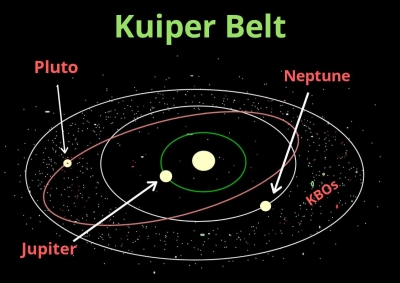
The inner edge of the Kuiper Belt begins at the orbit of Neptune, at about 30 AU from the Sun. (1 AU, or astronomical unit, is the distance from Earth to the Sun.)
The inner, main region of the Kuiper Belt ends around 50 AU from the Sun. Overlapping the outer edge of the main part of the Kuiper Belt is a second region called the scattered disk, which continues outward to nearly 1,000 AU, with some bodies on orbits that go even farther beyond.
Astronomers think the icy objects of the Kuiper Belt are remnants left over from the formation of the solar system. Similar to the relationship between the main asteroid belt and Jupiter, it’s a region of objects that might have come together to form a planet had Neptune not been there. Instead, Neptune’s gravity stirred up this region of space so much that the small, icy objects there weren’t able to coalesce into a large planet.
Just outside of Neptune’s orbit is a ring of icy bodies. We call it the Kuiper Belt.
This is where you’ll find dwarf planet Pluto. It’s the most famous of the objects floating in the Kuiper Belt, which are also called Kuiper Belt Objects, or KBOs.
There are bits of rock and ice, comets and dwarf planets in the Kuiper Belt. Besides Pluto and a bunch of comets, other interesting Kuiper Belt Objects are Eris, Makemake and Haumea. They are dwarf planets like Pluto.
Credit : NASA Solar System Exploration
Picture Credit : Google




